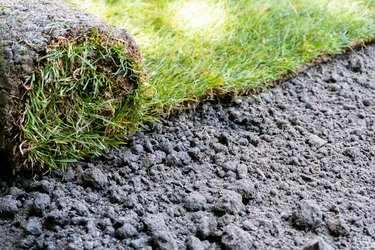
A lush lawn is a sight to behold. Sodding your lawn is a quick and easy way to replace struggling or dying turfgrass. Although more expense than seed, sod can be applied to your lawn in a single day. Sod also requires much less care than sown seed. Most homeowners go to the expense—in both work and actual financial burden—of removing their lawns before applying sod, which is the best way to get new grass off to a good start. Sod, though, can be applied directly over existing grass.
Sod Considerations
Video of the Day
When you lay sod in your yard, its health relies heavily on its ability to develop roots in the soil, where nutrients and water needed for growth are available. The nutrients that exist in sod are minimal, and sod can dry out or begin to struggle due to a lack of nutrients. The sod should quickly take root in your soil, adhering to the existing lawn after just a few weeks. The faster it takes root, the better it performs.
Video of the Day
Some gardeners theorize that leaving a layer of grass beneath new sod affects the sod's ability to take root in the soil and increases the chance that the new lawn will die from lack of nutrients, including the vital need for moisture. This is true if you attempt to lay sod over tall grass, because it will take a while before the new sod is able to take root in soil. And if you do not keep the new sod watered well, the roots will die before they can become established.
Because sod is much more expensive than grass seed, many individuals avoid sodding over grass out of fear that it will lead to the demise of the new sod. Mow your existing lawn until the grass is as short as possible so that the new sod's roots can make contact with the soil as quickly as possible.
Sod Over Grass
Professional landscapers often apply sod directly over grass. The sod compresses the grass and limits its exposure to sunlight and water. This quickly kills the already existing grass in much the same way that a brick left on a lawn kills the grass beneath it. When the grass dies, it gives off nutrients that actually benefit the new sod above it. The main nutrient that the dead grass layer provides is nitrogen.
Applying sod directly over grass is advantageous because it requires less site-prep work. The lawn does not need to be treated with herbicide. Also, you do not need to till your yard. This often means less expense. This is particularly true if you are hiring people to sod your lawn. Typically, they charge for all of the steps, which can include hauling away your old lawn.
Some lawncare experts shy away from applying sod over existing grass when they are concerned about the level of the sod in comparison with other surfaces. For example, some landscapers remove grass before applying sod near sidewalks and driveways, where it is better to have the base of the soil even with the hard surfaces.
Sod On Bare Ground
If you want to install sod on bare ground, till the soil. If your ground is already bare, you only need to grade it to ensure that it is level and drains water well. You also need to test your soil to determine if nutrients should be added. You can purchase a soil test from most garden centers, and you can have the soil sample tested by your local extension service. You should also test a soil sample if you are laying sod over grass.